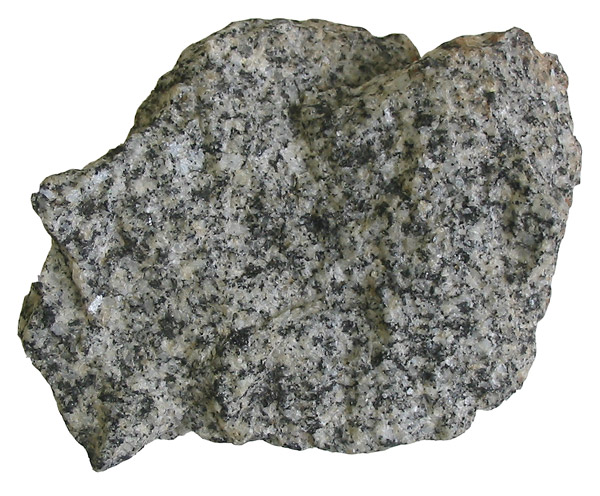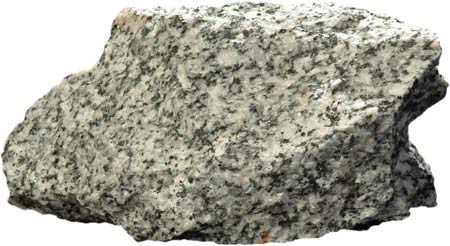Diorite
Diorite (Greek dihorízein: distinguish, discordant ) is a plutonic rock ( " plutonic " ) of dark to black, rarely also in the medium to light gray in color. Diorites are never colored. Your counterpart is the volcanic andesite. Diorite is in composition between granite and gabbro and tonalite is the similar.
Mineral composition
Diorite consists of a kristallisch - grained mixture of
- Plagioclase ( feldspar ) with a Anorthitanteil between 30-50 %
- Amphibole
- Pyroxene mafic or other admixtures
And little chlorite in quartz varieties can also be accompanied. From quartz diorite to quartz speaks at proportions of 5 to 20%. Where the quartz content this value is another rock, a tonalite, before. Also, with diorites as minor constituents, iron minerals, apatite, zircon and titanite. If the hornblende replaced by the dark Magnesiaglimmer, one speaks of the Glimmerdiorit.
A rarely occurring variant of the diorite is the Kugeldiorit, a ball or rock Orbiculit (French diorites orbiculaire ) of concentric spherical shells constructed. The emergence of such siliceous Orbiculite can be explained by the sudden hypothermia a superheated magma. Characteristic is the radial crystal growth. The growth speed of crystals and the diffusion of the components in the melt to determine the formation of the partially alternating shells which are formed by recrystallization Teilaufschmelzen and other rock parts.
Occurrence
The diorite forms transitions and sticks in the mountain, and it was mostly in stages from the Archean and the Paleozoic. Presence in Europe can be found in Ruhla, Brotterode, at the Ross Trappe, on Kyffhaeuser, in the Odenwald, in the Bavarian Forest in Upper Austria and the Iron Hills of Bohemia, in Normandy and Brittany.
The ancient Egyptian deposits from Mons Claudianus is a quarry landscape in Wadi Umm Hussein east of Gebel Fatira. The mining activity will have been started in the time of Emperor Claudius ( 41-54 AD). An intensive degradation period existed in the reign of Trajan ( 98-117 AD) and Hadrian ( 117-138 AD).
Kugeldiorit comes out to Ajaccio in Corsica (among quarry south of Sainte -Lucie- de -Tallano ) in Finland ( Ylöjärvi - Pengonpohja near Kuru ), Slättemossa at Järnforsen in Sweden and cottagers in large Gerungs in the Waldviertel (Lower Austria ) ago.
Applications
Ancient uses for diorites are versatile detectable. In Rome there are columns from the Egyptian quarries of Wadi Umm Hussein at the Imperial Forum, the Pantheon, Trajan Temple, Trajanforum, Palatine Hill, Temple of Venus and Roma, as well as at the Villa Hadriana.
Dark Dioritsorten were mainly in the 1950s and 1960s, still used occasionally as material for the monument design. There are usage examples Czech varieties of bridge veneers, columns and facades in Prague.
Most diorites take a good polish, but are technically difficult to work with because of their excellent strength properties. For this reason, they are represented in the architecture of modern times little. Occasionally, they are used for rotated objects, such as columns, tanks or vases. Kugeldiorite be processed by the memory industry.
Because of its good material properties are diorites in road construction application.








